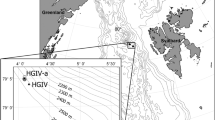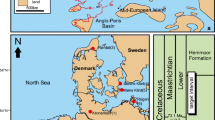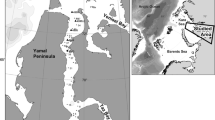Abstract
The benthic fauna off King George Island (South Shetland Islands, Antarctica) was investigated during "Polarstern" expedition ANT XV/3 in March 1998. Samples were taken along two cross-shelf/slope transects both north (Drake Passage) and south of the island (Bransfield Strait, off Potter Cove) at water depths ranging from 130 m to 2,000 m. For a quantitative inventory, a multibox corer was used at nine stations to collect mostly infaunal macrobenthos; at seven stations, seabed photography was employed concomitantly to survey the epibenthic megafauna. Macrofauna abundances ranged from 730 ind. m–2 at 2,000 m to >14,000 ind. m–2 at 100 m; biomass values varied between about 50 g wet mass m–2 (6 g ash-free dry mass m–2) at 2,000 m and about 950 g wet mass m–2 (about 90 g ash-free dry mass m–2) at 200 m. Densities were dominated everywhere by polychaetes, followed by bivalves, crustaceans and ophiuroids; in terms of biomass, krill and holothurians surpassed polychaetes at some stations. No significant differences between the northern and the southern transects in total abundance and biomass were obvious. Megafauna abundances were clearly higher south of King George Island, totalling about 110–150 ind. m–2 on the shelf (235–330 m) and about 50 ind. m–2 at the continental slope (750 m), whereas along the northern transect they reached values of only 21–31 ind. m–2 on the shelf (130–430 m) and decreased at the continental slope (950 m) to about 5 ind. m–2. A brittle star, Ophionotus victoriae, strongly dominated the southern-shelf epibenthos, with relative abundances of 70–95% and a biomass of about 40–80 g wet mass m–2 (about 4–7 g ash-free dry mass m–2), but was numerically less important at the slope (5%) where ammotheid pycnogonids prevailed (80%). Macro- and megabenthos distribution patterns were characterized by a pronounced shelf-slope gradient – in standing stock as well as in faunistic composition – but this resemblance was statistically not significant. This finding indicates that the spatial distributions of macrobenthos and megabenthos are primarily determined by a depth-dependent factor, most probably food supply, but apparently respond differently to secondary driving forces, possibly seabed features. Our results provide further evidence for the notion that there is no distinct latitudinal gradient in benthic abundance and biomass in the Southern Ocean between the South American Magellan region and high-Antarctic waters of the Weddell Sea.
Similar content being viewed by others
Author information
Authors and Affiliations
Additional information
Electronic Publication
Rights and permissions
About this article
Cite this article
Piepenburg, D., Schmid, M.K. & Gerdes, D. The benthos off King George Island (South Shetland Islands, Antarctica): further evidence for a lack of a latitudinal biomass cline in the Southern Ocean. Polar Biol 25, 146–158 (2002). https://doi.org/10.1007/s003000100322
Accepted:
Published:
Issue Date:
DOI: https://doi.org/10.1007/s003000100322




